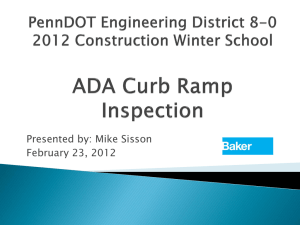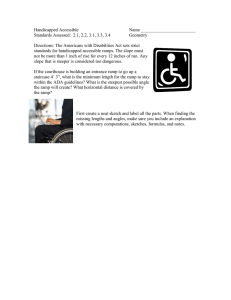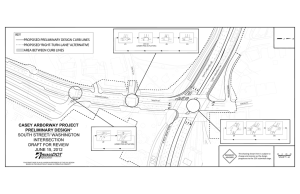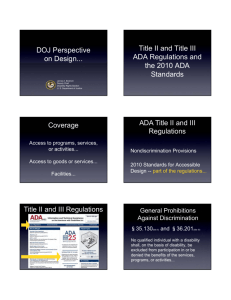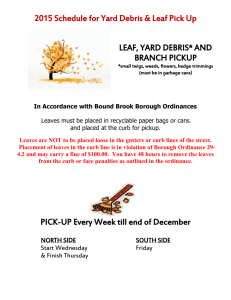ADA for Roads & Bridges * PROWAG
advertisement
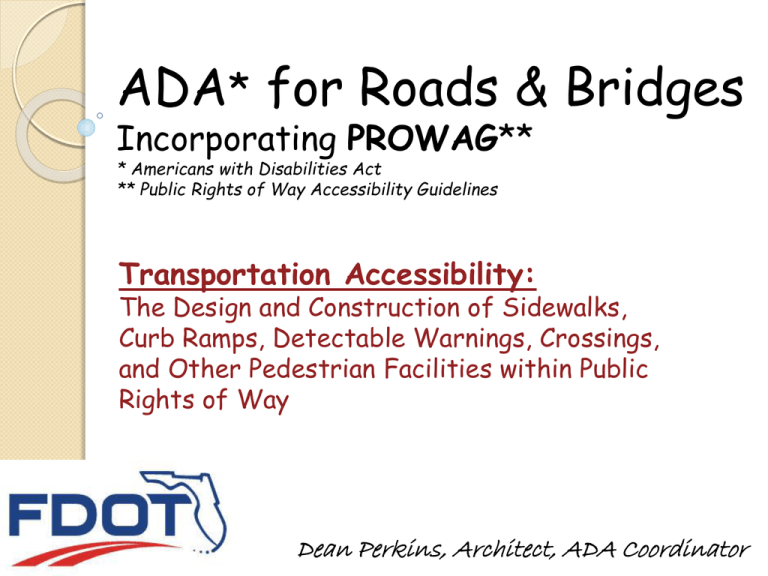
ADA* for Roads & Bridges Incorporating PROWAG** * Americans with Disabilities Act ** Public Rights of Way Accessibility Guidelines Transportation Accessibility: The Design and Construction of Sidewalks, Curb Ramps, Detectable Warnings, Crossings, and Other Pedestrian Facilities within Public Rights of Way Dean Perkins, Architect, ADA Coordinator Introduction Brief overview of ADA How ADA impacts FDOT projects Features of Accessibility New Concepts Random Images ◦ Some Good, Some Not So Good New “Issues” Background of the ADA ADA - Civil Rights Law ◦ 1964 - 1990 Federal Laws 1964 Civil Rights Act (Title VI) 1968 Architectural Barriers Act (federal buildings) 1973 Rehabilitation Act (s. 504 - federal programs) Background of the ADA 1990 Americans with Disabilities Act July 26, 1990 - signed July 26, 1991 –ADA Standards. January 26, 1992 – effective date July 26, 2004 – new ADA guidelines (ADA/ABA) Nov 23, 2005 – new PROW guidelines (PROWAG) Nov 26, 2006 – FHWA adopts ADA Standards for Transportation Facilities (ADASTF) ◦ July 23, 2011 – Access Board proposes issues NPRM for PROWAG (public comments) Comment period closed 2/2/2012 ◦ ◦ ◦ ◦ ◦ ◦ The Future of Accessibility within Public Rights of Way(?) USDOT / FHWA recommends using PROWAG criteria where ADASTF do not address an issue. • Frederick D. Isler, Associate Administrator for Civil Rights – January 23, 2006 RECOMMENDATION: Start learning PROWAG! www.access-board.gov/prowac/nprm.htm Transportation………. ADA and Sidewalks ADA is a federal civil rights law ◦ Enacted July 1990 – Effective January 1992 ◦ Title II – Public Services (of 5 Titles) Title IIa – State and Local Governments (services and facilities) Title IIb – Public Transportation (services and vehicles) ◦ ADA: ‘Public services’ must be accessible ◦ ADA: Public sidewalks along roadways ARE public services ◦ Public sidewalks include pedestrian access routes ◦ Curb ramps are part of pedestrian access route ◦ Features along sidewalks must be accessible Roadside Accessibility Accessible Route Requirements (PROWAG – Pedestrian Access Route) ◦ Clear Widths ◦ Running Slopes & Cross Slopes ◦ Surfaces ◦ Changes in Level, Gaps & Grates ◦ Protruding Objects Signs & Equipment Landscape Materials Accessible Route (AR) & Pedestrian Access Route (PAR) AR = 36” continuous unobstructed path ◦ PAR = 48” (FDOT Stds. & PROWAG) AR = 32” min. at a ‘point’ (24” max.) 60” x 60” passing space @ 200’ Slopes: 32” Min. 48” Min. ◦ ≤1:20 (≤5%) is not a ramp ◦ >1:20 (>5%) is a ramp ◦ 1:12 (8.3%) max. allowed * Cross-slope ◦ 1:48 (2%) max. allowed * ◦ 1:75 (1.5%) preferred * Exceptions in PROWAG 48” Min. 24” max. ◦ PAR = 48” (FDOT Stds. & PROWAG) Surfaces Firm, stable, slip-resistant ◦ Dry or wet! Changes in level ◦ ≤ ¼” – Vertical ◦ > ¼” ≤ ½” – 1:2 slope ◦ > ½” – 1:12 slope (ramp) ½” max. Gratings ◦ ½” max. gap (!!!) ¼” max. ½” max. Protruding Objects 27” - 80” range above grade Post-mounted (≤12” offset, ≤4” in PROWAG) Wall mounted (≤4” offset) Overhanging (≥27”≤80” above walking surface) Pedestrian Access Route (PAR) R302.3 Continuous Width The minimum continuous and unobstructed clear width of a pedestrian access route shall be 4 ft. exclusive of the width of the curb Measure from back of curb! 4’ The Sidewalk ‘Zone’ System Curb Zone Furniture Zone Pedestrian Zone (PAR) Frontage Zone Zone System: Residential Furniture Zone Pedestrian Zone (PAR) Zone System: Commercial Street Parking Furniture Zone Pedestrian Zone (PAR) Furniture Zone Carefully arranged street furniture leaves the sidewalk clear Randomly arranged street furniture clutters the sidewalk and creates an ‘obstacle course’ A Cross Slope Solution 2% 2% Change of Material and/or Texture Another… Steps A difference between AR & PAR! For sidewalks within the public right of way . . . Sidewalk grade – ADASTF vs. PROWAG • ADASTF: Provide accessible route (AR) • PROWAG: Match roadway grade (PAR) ADASTF PROWAG Ramps – “supported slopes” i.e., Bridges 5’ min. 30’ - 40’ max. 5’ min. Landing Depending on slope (see below) Landing “Level” means: 2% or less slope 30” max. Curb Ramps Running Slopes (1:12 / 8.3% max.) Cross-slopes (1:48 / 2% max.) Landing at top (48” min.) Detectable Warnings X = 48” min. ADAAG 4.7 Curb Ramp Grade R304 Least slope possible is preferred Recommended maximum grade to allow for construction tolerance – 7.1% Maximum grade – 8.3% Exception: when “chasing grade,” ramp length need not exceed 15’, but slope must be uniform Up to 15’ Change of Grade (Counterslope) R303.3.5 PROWAG allows 8.3% ramp and 5% grade at the adjacent street ◦ 13.3% maximum Recommendation: ◦ Provide 2’ level area if greater than 11.3% See notes in Index 304 Algebraic Difference Greater than 13% Not Permitted Transportation……… Transportation Curb Ramps and Detectable Warnings Curbs are an 'edge cue' for pedestrians who are blind or have low vision Curbs are a barrier for persons in wheelchairs Curb ramps remove the barrier for wheelchairs Curb ramps remove edge cue for peds with vision impairments Detectable warnings are a replacement cue to indicate location of the street Perpendicular Curb Ramps R305.2.1 Perpendicular Curb Ramp Place DW at back of curb or at grade break CR-A Ramp 24” Directional/Linear Ramps R305.2.1 Greater than 5 feet setback . . . Place DW on bottom landing if level landing is more than 5’ deep at any point > 5’ Ramp CR-G NOTE: These are hard to construct correctly Directional/Linear Ramps R305.2.1 Equal to or less than 5 feet setback from bottom of curb ramp . . . ≤ 5’ ◦ Place DW at grade break if level landing at bottom of ramp is 5’ deep or less CR-F Ramp These are much easier to build Parallel Ramps R305.2.2 CR-C Ramp Ramp LANDING 24” Blended Transitions R305.2.3 – “Full Width!” Detectable Warnings are Equivalent to “STOP” or “YIELD” signs’ Detectable warnings help delineate the edge of the street for a pedestrian who is blind or has low vision ◦ DWs generally, do not designate the best crossing location ◦ DWs generally, do not provide alignment information Detectable Warning Alignment To align or not to align . . . Detectable warnings ‘warn’ of roadway edge Dome alignment typically NOT used as directional cue ◦ Other methods: traffic sounds, sidewalk curbs, APSs (if available), etc. In a perfect world, truncated domes would be aligned with the crossing ◦ Easier to construct ◦ Easier to use However, not all curb ramp configurations or site conditions permit TD alignment Detectable Warning Alignment To align or not to align . . . So… ◦ Dome alignment is desirable, but not required Perfect World Real World Pedestrian Controls R209 & MUTCD 4E.08 In reach ranges (48” max.) ◦ 42” FDOT Standard ◦ 10” max. reach - over obstruction/edge of sidewalk ◦ 2” dia. raised buttons Maneuvering space 3’-6” Index 17784 (30” x 48” min., level) Pushbutton Locations R403 & MUTCD 4E.08 NOTE: It must be clear which button controls which crossing. (per MUTCD). Accessible Pedestrian Signals R209 & MUTCD 4E.09-4E.13 For pedestrians with vision impairments Used in conjunction with pedestrian signal timing Add “non-visual” information: • ◦ ◦ ◦ ◦ Tactile features Audible tones Vibrating surfaces Speech messages Must indicate which crossing is served by each device ◦ If less than 10’-12’ apart, must ‘talk’ to you Accessible Pedestrian Signals On APL Speakers Tactile Arrows Accessible Pedestrian Signals Locator tone then walk indication APS Location Good placement of pedestrian detectors with APSs Not-so-good placement Pedestrian Crossings R306 Slope of crossing = cross-slope of roadway Cross-slope of crossing = grade of roadway Cross-Slope of crossing: ‘STOP’/’YIELD’-controlled: 2% max. Non stop/yield-controlled: 5% max. i.e., Signal or No Control Mid-block: Match grade of roadway Transportation Pedestrian Crossing Treatments Enhanced signs In-pavement flashers Detectable warnings RRFB Rectangular Rapidly Flashing Beacon RRFB “Push button to activate” Pedestrian Hybrid Beacon MUTCD 4F Stays dark for vehicles and solid 'hand' for pedestrians until activated, then: For vehicles: 1. 2. 3. 4. 5. Flashing Yellow light, Solid Yellow light, Solid Red lights Alternating Red lights, Then dark For pedestrians: 1. 2. 3. 4. 5. Solid Hand, Solid Hand, Solid Walk, Flashing Hand Solid Hand Crossings R306 Curb Ramp “wholly within” marked crossing Check Transitions (13.3% max., 11.3% rec.) ◦ Ramp slope = 8.3% max. ◦ Roadway cross-slope = 5% max., 3% rec. Verify Slopes (1:12 max.) Cross-slopes Look for Level changes Pedestrian Controls ◦ Level Maneuvering Space (30”x48” min.) Index 17346 Bus Stops R308 When siting a new bus stop… ◦ Must be on PAR 48” min. 60” recommended This may be sidewalk or paved shoulder ◦ Must have accessible approach to bus stop 48” min. width – 60” recommended Leads to / part of boarding & alighting area Meets running slope/cross slope criteria Firm, stable & slip-resistant ◦ Must consider potential construction of boarding and alighting area & other features Bus Stops If provided – Boarding & Alighting area: ◦ Place for bus lift/ramp to deploy ◦ “Firm, stable and slip-resistant” surface (ADAS & PROWAG) ◦ Must connect to streets, sidewalks, etc. Sidewalk, curb ramps, etc. ◦ 5’ min. width – parallel to roadway ◦ 8’ min. depth – perpendicular to roadway 5’ x 8’ B&A area NOTE: If low-floor, ramp-equipped bus is used, the B&A area should be raised (curb height). Bus Stops If provided – bus bench: ◦ Must be on PAR ◦ Must not block PAR 48” min. clearance – 60” recommended ◦ Must have maneuvering space adjacent to bench 30” x 48” min.; firm, stable & slip-resistant surface Allow shoulder-to-shoulder seating for companion ◦ Allow transfer to bench (if desired) Seat length: 42” min. Seat height: 17”-19” Seat back: 2”-18” above seat Armrest recommended Bus Stops If provided – bus shelter: ◦ Must be on PAR ◦ Must not block PAR 48” min. clearance – 60” recommended ◦ 30” x 48” min. clear floor area within shelter ◦ 48” min. approach to clear floor area ◦ 48” min. approach to boarding & alighting area Rural bus stops Primary Issues: ◦ Flush shoulder – No curb ◦ Shoulder is sloped away from the roadway ◦ Most ‘kneeling’ buses are designed to deploy front ramps onto 6” high curbs Up to 1:4 slope allowed on bus ramp deployed onto curb (ADAASTV*, 49 CFR 38.23(c)(5)) ◦ Use on flush shoulder causes ramp to be too steep for safe use. * ADAASTV = ADA Accessibility Specifications for Transportation Vehicles • • • • Slope may be 1:4 if ≤3” above 6” curb Slope may be 1:6 if >3” to ≤6” above 6” curb Slope may be 1:8 if >6” to ≤9” above 6” curb Slope may be 1:12 if >9” above 6” curb Bus Ramp & Lift Design High-floor bus with lift at rear door Lift – May be deployed on 6” high curb or at ground level – level platform. Bus Ramp & Lift Design Low-floor bus with ramp at front door Probably the most common 4-12 1 Ramp: Designed to be deployed on 6” high curb to provide 1:4 or less slope. (Max. allowed under ADASTV) 3+ 1 Ramp: Deployed at ground level is too steep – 1:3 slope or more. Rural bus stops Parking Accessible space ◦ Width = 12’-0” min. Access aisle ◦ Width = 5’-0” min. Curb ramp ◦ Outside space & aisle Slopes ◦ 1:48 max. any direction Index 17346 Exceptions & Variations “Technical Infeasibility” What to do if you cannot fully comply? Each facility or part of a facility altered by a public entity in a manner that affects or could affect the usability of the facility or part of the facility shall, to the maximum extent feasible, be altered in such manner that the altered portion of the facility is readily accessible to and usable by individuals with disabilities (§35.151(b)(1)) Exceptions & Variation “Technical Infeasibility” What to do if you cannot fully comply? (cont.) If full compliance would be structurally impracticable, compliance is required to the extent that it is not structurally impracticable. Full compliance will be considered structurally impracticable only in those rare circumstances when the unique characteristics of terrain prevent the incorporation of accessibility features. (§35.151(a)(2)) Maintenance of PAR 28 CFR 35.133 Title II of the ADA requires public entities to maintain equipment and features of facilities that are required to provide ready access to individuals with disabilities Potential Solutions Sidewalk Grinding Flexible Pavement Joint Materials Alternate Pedestrian Routes R205 & R303 and MUTCD 6D & 6G Alternate Pedestrian Access Routes are required when an existing pedestrian access route is blocked by construction, alteration, maintenance, or other temporary condition. Alternate PARs See similar requirements in FDOT Index 660 Alternate PARs R205 specifies that the alternate pedestrian access route shall be: ◦ Provided on the same side of the street as the disrupted route, to the maximum extent feasible ◦ Where exposed to adjacent construction, traffic or other hazards, shall be protected with a pedestrian barricade or channelization device Continuous, stable, non-flexible Consist of features identified in the MUTCD Chapter 6F • Plastic tape is not acceptable!!! • Rows of barrels and/or cones is not acceptable… unless they are connected by a continuous ‘detectable’ edge Longitudinal Channelizing Devices (LCDs) Hand Trailing Edge Detectable Edge 12. For pedestrian longitudinal channelizing devices, the device shall have a minimum of 8” continuous detectable edging above the walkway. A gap not exceeding a height of 2” is allowed to facilitate drainage. The top surface of the device shall be a minimum height of 32” and have smooth connection points between the devices to facilitate hand trailing. The bottom and the top surface of the device shall in the same vertical plane. If pedestrian drop-off protection is required, the device shall have a footprint or offset of at least 2’, otherwise the device must be 42” in height above the walkway and be anchored or ballasted to withstand a 200 lb. later point load at the top of the device. FDOT Design Standards -Index 600 Construction Work Zones Unfortunately, too many bad examples… Very good! Measure before you build (Identity withheld) Latest from DOJ & DOT! Resurfacing and Curb Ramps Clarification of existing regulations: ◦ 28 CFR 35.151, "alterations require the inclusion of accessible features" New "Joint Technical Assistance" ◦ What is an 'alteration', and ◦ What is 'maintenance' www.fhwa.dot.gov/civilrights/programs/doj_fhwa_ta.cfm Prior to DOJ/DOT Agreement... USDOJ Patching Potholes USDOJ Everything Else USDOT “Non-structural“ resurfacing USDOT “Structural“ resurfacing Alterations vs. Maintenance An alteration is a change that affects or could affect the usability of all or part of a building or facility. ◦ Alterations of streets, roads, or highways include activities such as reconstruction, rehabilitation, resurfacing, widening, and projects of similar scale and effect. Maintenance activities on streets, roads, or highways, such as filling potholes, are not alterations. www.ada.gov/regs2010/titleII_2010/titleII_2010_regulations.htm - S. 35.151(b)(1) When Curb Ramps ARE required - Alterations Curb Ramps are required if resurfacing involves work on a street or roadway spanning from one intersection to another, and includes overlays of additional material to the road surface, with or without milling. ◦ Basically, if you're adding or replacing asphalt. Examples of Alterations: New layer of asphalt Reconstruction & Rehabilitation Mill-and-fill Open-graded surface course Micro-surfacing/Thin-lift overlays Cape seals In-place asphalt recycling New construction Etc. When Curb Ramps are NOT Required - Maintenance Treatments that serve solely to seal and protect the road surface, improve friction, and control splash and spray are considered to be maintenance because they do not significantly affect the public's access to or usability of the road. ◦ Basically, if you're just coating the surface and not adding asphalt. Examples of Maintenance ◦ ◦ ◦ ◦ ◦ ◦ ◦ Painting or striping lanes Crack filling & sealing Surface sealing Chip seals Slurry seals Fog seals Scrub sealing Joint repairs Dowel bar retrofit Spot high-friction treatments Diamond grinding Pavement patching Pot-hole repairs Etc. After to DOJ/DOT Agreement... Chip Seals plus Fog Seals Scrub Seals Crack Filling & Sealing Joint Crack Seals Slurry Seals Diamond Grinding Spot High-Friction Treatments Joint repairs Dowel Bar Retrofit Addition of New Layer of Asphalt Cape Seals Hot In-Place Recycling Microsurfacing / Thin-Lift Overlay Pavement Patching Mill & Fill / Mill & Overlay New Construction Open-graded Surface Course 3-R What About Crosswalks? Crosswalks constitute distinct elements of the right-of-way intended to facilitate pedestrian traffic. Regardless of whether there is curb-tocurb resurfacing of the street or roadway in general, resurfacing of a crosswalk also requires the provision of curb ramps at that crosswalk. For example… Crossings… Please Note: ◦ This TA does not describe new requirements from DOJ or DOT. ◦ This TA does not change Florida DOT policy. ◦ This is a clarification of current requirements. Random Images Some good Some not so good This is what we want… Not this . . . Or this . . . Nice! Ummm… This (sorta) works Maintenance please!!! Well Done! Old Crossing Fixed Crossing Curb Ramps OK, but . . . Nice! Close… DW needs to be full width Very Good! We’re not finished, right…? Very Good! This is a little hard to fix. Creative path around large tree up and over the roots Combination return curb and flared side Full Width Good! Large Gap . .…. BAD!!! Ummm! Good start, but… 80”? Looks good. Might want •July 16to check that limb, tho’. Very Good! Very Good! This CAN be fixed. 48” Walk around at driveway apron Hot Issues Elements, Features, Devices provided by others on the SHS Could these get FDOT in trouble? Bus Stops Shelters, Benches, etc. Railroad Crossings Sidewalk gaps, materials, flangeways, etc. Utilities Poles, hydrants, pull-boxes, etc. Nice shelter – But, how do I get here? Potentially unsafe for all peds, especially those using mobility aids “Hey… Let’s cut up the sidewalk an put in a pole!” Summary ADA Title II – Public Services – Public services must be accessible – Public sidewalks are public services – Public sidewalks are accessible routes – Curb ramps are part of accessible route – Features on sidewalks and curb ramps must be accessible Help is available State: ◦ FDOT District ADA Coordinator ◦ FDOT C.O. ADA Coordinator Federal: ◦ U.S. Access Board ◦ U.S. Department of Justice ◦ U.S. Department of Transportation FHWA FTA FRA Resources U.S. Access Board ◦ Accessibility Guidelines - ADAAG ◦ www.access-board.gov U.S. Dept. of Justice - ADA ◦ Accessibility Standards for Facilities & Sites ◦ www.ada.gov U.S. Dept. of Transportation – FHWA ◦ Accessibility Guidance & Standards for Public Rights of Way ◦ www.dot.gov/citizen_services/disability/disability.html Florida Dept. of Transportation - FDOT ◦ ADA information on Website ◦ http://www.dot.state.fl.us/projectmanagementoffice/ADA/ Contact us... Dean Perkins, Architect ADA Coordinator 850-414-4359 dean.perkins@dot.state.fl.us or Your District ADA Coordinator(s) Thank You! Merci! Todah Rabbah Arigato! Dhanya Vaad! Gracias! Xie Xie! Shokran! Danke! Live long and prosper! What WERE they thinking!?!
